
Members of a design team from the Department of Biomedical Engineering at Johns Hopkins University are shown with the pediatric ICU walker the AmbuMate. Pictured (l-r) are design team members Kriti Jindal, Shreya Narayan (standing in as a patient), and Nolan Benner.
AmbuMate, a walker designed by an undergraduate team from the Department of Biomedical Engineering at Johns Hopkins University, aims to help get pediatric kids in the ICU on their feet and out of the hospital faster.
“In the PICU, patients often have a lot of different pieces of equipment tethered to them,” says Nolan Benner, a senior studying biomedical engineering and the design team leader. This means that patients often need the assistance of up to five nurses and therapists to help drag large monitors and medical devices along, he says.
“We saw an opportunity to make that process a little easier for the nurses and patients involved,” Benner adds, in a media release.
As a way to assist with this process, the team designed the AmbuMate, a walker that makes it easier to transport multiple medical devices hooked to the patient, facilitating ambulation in the PICU.
It has various conveniences to improve the experience of patients and caregivers, such as support for patient fatigue and wire/tube management to make the process less chaotic. The AmbuMate’s features will also reduce the set-up time needed for the ambulation compared to its adult ICU competitors.
Sapna Kudchadkar, an associate professor of anesthesiology and critical care medicine at the Johns Hopkins School of Medicine, as well as director of the Johns Hopkins PICU Clinical Research Program, approached the BME design team course instructors about the project.
“We wanted a contraption where you could put all of the equipment in the same place and move everything as one unit,” Kudchadkar says.
The movement toward early mobility for PICU patients first originated at Johns Hopkins Hospital in 2013, when Kudchadkar and a team of nurses, therapists, and other stakeholders came together to create the PICU Up! protocol.
The protocol is built on the premise that regularly scheduled activity for hospitalized children helps them recover faster. Nurses and practitioners establish a daily routine that improves patients’ sleep hygiene. This means no naps during the day and never being woken up for bath time or X-rays during the night (as is otherwise usual).
If the children are extremely sick, they are passively exercised, meaning someone else helps them move their muscles. As children get better, they are made to sit on the edge of their bed, stand, or sit in a chair close to the bed. Some even go so far as to be able to walk around the PICU with a breathing tube attached.
“We needed a multidisciplinary program to create a culture of mobility, to say it’s OK to keep kids more awake and to get them exercising earlier,” Kudchadkar states, in the release. “Then, they can come off the ventilator sooner, they can leave the ICU sooner and, hopefully, get back to the quality of life that they had before their illness.”
The Johns Hopkins student design team hopes to market its device to PICUs that are adopting Kudchadkar’s PICU Up!
“We’d love to take this to market, actually have our device being used in pediatric intensive care units and adult ICUs to help patients walk and feel better, improve patient outcomes and probably make life easier for nurses as well,” Benner concludes, in the release.
[Source(s): Johns Hopkins University, Newswise]



